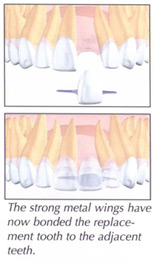Often people underestimate the value of every tooth in the terms of beauty- even those in the back of the mouth. Although the spaces created by these missing teeth may not be visible, they can cause a variety of problems and start a vicious cycle of destruction. In a normal, healthy mouth, your teeth have a natural balance. Each upper tooth contacts the corresponding lower tooth, allowing for a well-balanced chewing function. Losing a tooth quickly destroys this balance. Just one missing tooth can cause the position of other teeth to change – some teeth may tilt forward, or opposing teeth may move down. A missing tooth can also create spaces between your teeth, changing your bite and smile. These shifting, drifting, and tilting teeth can cause a variety of problems such as difficult or painful chewing (due to changes in your muscles, bones, and joints), or abnormal decay areas (due to teeth that are hard to reach and keep clean) which accelerates periodontal (gum) disease. Generally, if the missing tooth is not replaced, more teeth may eventually be lost due to the improper forces exerted during chewing.
In short, by replacing missing teeth you can:
There are two main types of bridges: conventional and Maryland. A conventional bridge has replacement teeth that are attached to crowns that fit over your natural teeth on either side of the space to be filled. The replacement teeth plus the crowns form a solid unit that is cemented into place to restore your natural bite.

In this example, one tooth on either side of the missing tooth is prepared to retain the fixed bridge.

Porcelain is normally fused to a metal framework. Here the metal framework is being tried in the mouth.

The final porcelain-fised-to-metal bridge is fitted over the teeth and just under the gum tissue.
A Maryland Bridge has replacement teeth that are attached to the back of nearby natural teeth using a metal or porcelain strip. This type of bridge may be an option if the next to the bridge may be an option if the teeth next to the bridge are in good condition.
The two adjacent teeth are slightly prepared and very little enamel is reduced. Backs of the teeth and the inside of the metal “wings” are attached and attached together with a strong cement.

It will take two or more dental visits to prepare and fit our bridge. First your dentist reshapes the support teeth that will hold the crowns of your fixed bridge. Then an impression of the prepared tooth, and of the surrounding and opposing teeth, is taken. If appearance counts, your dentist selects a colour from a guide to make sure the replacement teeth match the colour of your natural teeth. To protect your prepared teeth while the fixed bridge is being made, your dentist may fit a temporary bridge that is held in place by temporary cement.
Between visits expect to wait about one week while the lab work is being done. Be careful when cleaning your teeth or eating, because your temporary bridge can loosen. Let your dentist know immediately if the temporary bridge comes off or does loosen.
At your second visit, your temporary bridge is removed and your dentist places the fixed bridge onto your prepared teeth, adjusting it in your mouth. When the fit and bite are comfortable, the fixed bridge is cemented into place. If after trying the bridge for a few days you think it needs further adjusting, call your dentist.
In certain situations, and if your surrounding teeth are in good condition, your dentist may recommend the Maryland bridge. Talk to your dentist to determine if this is a good option for you.
Fixed bridges appear and function similar to natural teeth. They remain in the mouth at all times and can only be removed by your dentist. Because trimmed down natural teeth (abutments) must carry the load of missing teeth, sometimes they can be overloaded. Patients need to “favour” the bridged areas slightly to avoid overloading and potentially loosing or damaging the prostheses.
Good oral hygiene can help your bridge last a long time. You can extend your treatment life expectancy by:
Alternatives to fixed bridges include removable partial dentures which are the most common alternative, or implants with crowns and/or fixed prostheses placed over them.
If you have any further questions about fixed bridges or if you notice a problem with your bridge already in place, call your dentist.
